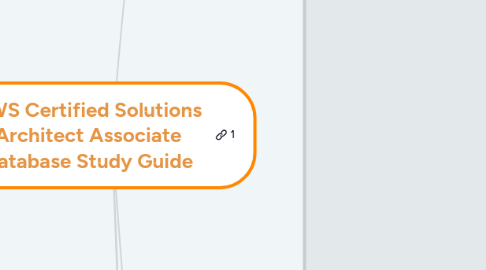
1. Relational
1.1. RDS
1.1.1. Database Engines
1.1.1.1. Aurora
1.1.1.1.1. MySQL Edition
1.1.1.1.2. PostgreSQL Edition
1.1.1.1.3. 1 day free Automatic Backup
1.1.1.1.4. 6-way replication across three Availability Zones
1.1.1.2. PostgreSQL
1.1.1.3. MySQL
1.1.1.3.1. Storage Engines
1.1.1.4. MariaDB
1.1.1.5. Oracle Database
1.1.1.6. SQL Server
1.1.2. Instances
1.1.2.1. Examples
1.1.2.1.1. db.m5.xlarge
1.1.2.1.2. db.r5.large
1.1.2.1.3. db.t2.small
1.1.2.2. Maximum of 40 Instances
1.1.3. Storage
1.1.3.1. Elastic Block Store (EBS)
1.1.3.1.1. Autoscaling capable
1.1.3.1.2. Magnetic
1.1.4. Multi-AZ
1.1.4.1. Automatic Failover to Standby Instance
1.1.5. Read Replicas
1.1.5.1. Horizontal Scaling
1.1.6. Backups
1.1.6.1. Automatic Backup
1.1.6.1.1. 35 day Maximum Retention Period
1.1.6.1.2. Point-in-time Recovery
1.1.6.2. Database Snapshot
1.1.6.2.1. Stored indefinitely until explicit deletion
1.1.7. Monitoring performance
1.1.7.1. Management console
1.1.7.2. Metrics
1.1.7.2.1. IOPS
1.1.7.2.2. Latency
1.1.7.2.3. Throughput
1.1.7.2.4. Que Depth
1.1.7.3. CloudWatch
1.1.7.3.1. Enhanced Monitoring - Paid Option
1.2. Redshift
1.2.1. Data Warehouse
1.2.1.1. Combine multiple data sources into one - EMR, DynamoDB, or any SSH-enabled host.
1.2.1.2. ETL (Extract, Transform, Load)
1.2.1.2.1. Amazon Glue
1.2.1.2.2. AWS Data Pipeline
1.2.1.2.3. Build your own ETL Pipeline
1.2.1.2.4. Third-party cloud ETL Service
1.2.1.3. SQL Queries
1.2.1.3.1. Save Results to S3
1.2.2. Single AZ Deployments
1.2.2.1. Deploys in clusters
1.2.2.1.1. Up to 128 nodes
1.2.2.1.2. Concurrency Scaling
1.2.3. Maintains 3 copies of your data
1.2.3.1. Original & Replica on compute nodes
1.2.3.2. Automatic Backup on Amazon S3
1.2.3.2.1. 1 day retention (Default)
1.2.3.2.2. 35 day maximum retention
1.2.3.2.3. Free backup storage equal to your total Redshift storage
1.2.4. Disaster Recovery
1.2.4.1. Asynchronously replicate your snapshots to S3 in another region
1.2.5. Redshift Spectrum
1.2.5.1. Query files in S3 without having to load the data into Redshift tables.
1.2.5.1.1. Able to run multiple clusters accessing the same data for different use cases.
1.2.6. Metrics - Free of charge
1.2.6.1. AWS Management Console
1.2.6.2. Amazon Cloudwatch
1.2.7. Security
1.2.7.1. Encryption at Rest
1.2.7.1.1. AES-256
1.2.7.1.2. Supports S3 (SSE-KMS)
1.2.7.1.3. Hardware Security Module (HSM) via Client/Server Certificates
1.2.7.2. Encryption in Transit
1.2.7.2.1. SSL
2. Non-Relational
2.1. DynamoDB
2.1.1. Database Format
2.1.1.1. NoSQL
2.1.1.2. Key-value
2.1.1.3. Document
2.1.2. Serverless
2.1.2.1. Access via API
2.1.2.1.1. AWS SDK
2.1.2.1.2. REST - GET/PUT, etc
2.1.2.2. Access via Console
2.1.3. Capacity Modes
2.1.3.1. Provisioned read/write
2.1.3.1.1. Use Cases
2.1.3.1.2. Free Tier Eligible
2.1.3.1.3. Automatic Scaling Option
2.1.3.2. On-demand
2.1.3.2.1. Use Cases
2.1.3.2.2. Pay only for what you use
2.1.4. Synchronously replicates data across three AZs in a Region
2.1.5. Read Consistency
2.1.5.1. Eventually consistent reads (Default)
2.1.5.1.1. Best Read Performance
2.1.5.2. Strongly consistent reads option
2.1.5.2.1. Use case: App needs to read an update within 1 second
2.1.6. Encryption at Rest
2.1.6.1. AWS Key Management Service (AWS KMS)
2.1.6.1.1. Customer Master Key (CMK)
2.1.7. Access Control
2.1.7.1. Web Identity Federation
2.1.7.1.1. Facebook
2.1.7.1.2. Google
2.1.7.1.3. Login with Amazon
2.1.8. Optional paid features
2.1.8.1. Continuous backup (Point-in-time Recovery)
2.1.8.1.1. Takes continuous backups for the preceding 35 days
2.1.8.2. On-demand backup
2.1.8.2.1. Takes snapshot backups at specified points in time
2.1.8.3. Restore from backup
2.1.8.3.1. Restores a table to a specific snapshot or time
2.1.8.4. Global tables
2.1.8.4.1. Replicates data to create a multiregion, multimaster table
2.1.8.5. DynamoDB Accelerator (DAX)
2.1.8.5.1. Reduces latency through in-memory cache
2.1.8.6. DynamoDB Streams
2.1.8.6.1. Provides a time-ordered sequence of item-level changes on a table
2.1.8.7. Data transfer out
2.1.8.7.1. Transfers data to other AWS regions
3. In-memory
3.1. Elasticache
3.1.1. Caching Engines
3.1.1.1. Redis
3.1.1.1.1. Multi-AZ with Auto-Failover
3.1.1.1.2. Back up & Restore Capable
3.1.1.1.3. Single Cluster mode
3.1.1.1.4. Multi-Cluster mode
3.1.1.1.5. Security
3.1.1.1.6. Disaster Recovery
3.1.1.2. Memcached
3.1.1.2.1. Up to 20 nodes
3.1.1.2.2. Intended to speed up dynamic web applications
3.1.2. Pricing
3.1.2.1. Free tier
3.1.2.1.1. 750 hours per month
3.1.2.2. On-demand nodes
3.1.2.2.1. Resources you consume by hour
3.1.2.3. Reserved Nodes
3.1.2.3.1. 1 or 3 year term
3.1.2.3.2. Discounted hourly usage rate
3.1.3. Use Cases
3.1.3.1. Read-Heavy Application Workloads
3.1.3.1.1. Social networking
3.1.3.1.2. Gaming
3.1.3.1.3. Media Sharing
3.1.3.1.4. Q&A Portals
3.1.3.2. Compute-Intensive Worloads
3.1.3.2.1. Recommendation Engine
3.1.4. Free CloudWatch Monitoring
4. Graph
4.1. Neptune
4.1.1. Graph Models
4.1.1.1. Property Graph
4.1.1.1.1. Query Language
4.1.1.2. W3C's RDF
4.1.1.2.1. Query Language
4.1.2. Use Cases
4.1.2.1. Applications that work with highly connected datasets
4.1.2.1.1. Recommendation engines
4.1.2.1.2. Fraud detection
4.1.2.1.3. Knowledge graphs
4.1.2.1.4. Drug discovery
4.1.2.1.5. Network security
4.1.3. Features
4.1.3.1. Fully managed graph database service
4.1.3.2. High Available
4.1.3.3. Read Replicas
4.1.3.4. Point-in-Time Recovery
4.1.3.5. Continuous Backups to Amazon S3
4.1.3.6. Replication across AZs
4.1.3.7. Encryption at Rest

